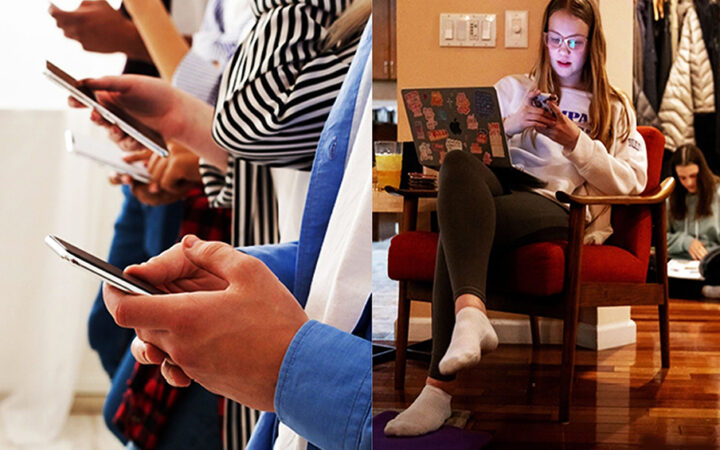As Kate Bulkeley discovered, navigating high school without social media is no easy feat. Initially, her decision to stay off social media brought numerous benefits: stellar grades, more time for reading, and engaging family activities like lively dinner conversations and movie nights. However, as sophomore year began, Kate encountered unforeseen challenges. She missed a student government meeting organized via Snapchat and faced scheduling issues with her Model UN team, which relied on social media for communication. Even her Bible Study club used Instagram to connect.
Gabriela Durham, a senior from Brooklyn, credits her social media-free lifestyle with shaping her into a focused and organized straight-A student who has already received multiple college acceptances and made her Broadway debut as a dancer. While Gabriela acknowledges feeling like an outsider at times, she now views this as a badge of honour rather than a source of hurt.
As the harmful effects of social media become more widely recognized, some parents are opting to impose restrictions or outright bans on their children’s usage. Many teenagers, aware of the negative impact on their mental health and academic performance, are voluntarily taking social media breaks or “cleanses”.
Despite the growing awareness of social media’s drawbacks, abstaining from these platforms can be incredibly challenging for teenagers today. Those who attempt to avoid social media often find themselves facing a mix of isolation, liberation, and significant life changes. Their experiences highlight the complexities of navigating a high school environment where most peers are deeply immersed in the digital world.
The stories of Kate and Gabriela illustrate both the rewards and the pitfalls of forgoing social media in a society where it is omnipresent. Concerns about children’s phone use are not new, but the COVID-19 pandemic has significantly intensified these issues. As youth dealt with isolation and increased online activity during the pandemic, social media became even more entrenched in their lives, fundamentally altering adolescence. This tale of two families sheds light on the evolving landscape of teenage life without social media, revealing both the struggles and triumphs that come with it.
Social media has evolved far beyond a mere distraction or a way to connect with friends. It now serves as a crucial community space that nearly all US teenagers are part of. According to the Pew Research Center, up to 95 per cent of teenagers use social media, with over a third reporting that they are on it “almost constantly”. This seamless integration of digital and non-digital worlds is something most adults fail to grasp fully, says Michael Rich, a paediatrics professor at Harvard Medical School and head of the Digital Wellness Lab at Boston Children’s Hospital.
“Social media is now the air kids breathe,” Rich states, highlighting its pervasive influence. It’s where teenagers forge their identities, seek advice, unwind, and relieve stress. This digital landscape impacts how they dress, talk, and socialize. In an era dominated by parental control apps and location tracking, social media offers this generation a sense of freedom. However, the extensive time spent online comes with increased risks. Studies cited by US Surgeon-General Vivek Murthy reveal that kids who use social media for more than three hours a day face double the risk of depression and anxiety.
These concerns drove Kate Bulkeley’s and Gabriela Durham’s parents to establish strict rules from a young age. Phones were delayed until middle school, and social media was banned until age 18. They educated their children on the potential impacts of social media on young brains, online privacy concerns, and the dangers of posting content that could have long-term consequences.
For Gabriela, a high school senior in Brooklyn, growing up without social media has been both isolating and liberating. At school, on the subway, and at dance classes, she is constantly reminded that social media is omnipresent – except on her phone. While this has meant missing out on jokes, TikTok dances, and viral trends, Gabriela now sees her lack of social media as a form of freedom. This absence of social media has also led to fewer screen-time battles at home, a small consolation in the face of the broader societal challenge.
Despite the clear benefits, the path isn’t always easy. For teenagers like Gabriela and Kate, staying off social media in a world saturated by it can be isolating. Yet, their journeys underscore the potential rewards of navigating adolescence without the constant presence of social media.
Gabriela Durham, a dance major at the Brooklyn High School of the Arts, dances outside of school seven days a week. Her senior year has been particularly intense, filled with college and scholarship applications, culminating in an unexpected highlight: performing at Broadway’s Shubert Theatre in March as part of a city showcase of high school musicals.
After a Saturday afternoon dance class in a Bronx church basement, the contrast between Gabriela and her peers becomes evident. The other dancers, aged 11 to 16, sit on the linoleum floor discussing social media. Fifteen-year-old Arielle Williams admits her addiction to TikTok, staying up until 5 am scrolling through videos. When she reveals she spent 68 hours on her phone the previous week, including 21 hours on TikTok, the other dancers gasp and check their own screen-time stats. Gabriela listens silently but later shares her thoughts on the subway ride home to Brooklyn, calling those screen-time hours “insane.”
Gabriela’s perspective as an outsider makes her keenly aware of the superficiality promoted by social media. “It seems like a lot of kids use social media to promote a facade. And it’s really sad because social media is telling them how they should be and how they should look. Everyone wants to look the same instead of being themselves,” she says. Gabriela feels fortunate to avoid the friend drama and lack of honesty, humility, and kindness that social media often fosters.
On the No 2 subway, Gabriela uses her phone sparingly, texting friends, listening to music, and using a subway app to track her stops. Her mother, Elena Romero, has strategically limited phone usage by keeping her children’s schedules packed. Romero describes their routine as a whirlwind, starting at 5:30 am and involving a daily commute to various schools in Brooklyn before Romero heads to her job in Manhattan teaching mass communications at the Fashion Institute of Technology.
Gabriela’s younger sisters, Grace, 11, and Gionna, 13, also have busy schedules. Grace is a sixth-grade cheerleader and active Girl Scout, while Gionna participates in debate teams and daily rehearsals for her middle school theatre production. Their tightly managed schedules leave little room for the excessive screen time that plagues many of their peers, fostering a more balanced approach to technology use in their homes.
“I’m so booked my free time is to sleep,” says Gabriela, who aims to be in bed by 10:30 pm. In New York City, it’s common for kids to get phones in elementary school, but Romero waited until middle school when her daughters began commuting alone. Years ago, she showed them “The Social Dilemma”, a documentary that revealed how tech companies manipulate users, which deeply impacted Gabriela.
Romero’s rules are straightforward: no social media on phones until 18. The girls can use YouTube on their computers but cannot post videos. Romero doesn’t set screen-time limits or restrict phone use in bedrooms. “It’s a struggle, don’t get me wrong,” she admits. Last year, the two younger girls secretly downloaded TikTok but were caught and received a stern lecture.
Romero is contemplating bending her rules for Gionna, an avid reader who dreams of becoming a Young Adult “Bookstagrammer” on Instagram. Gionna wants to be a writer and loves the idea of receiving free books for reviews. Romero is conflicted, as her primary concern was social media during middle school, a critical period for identity formation. She supports using social media responsibly to pursue passions and tells her girls, “When you’re a little older, you’ll realize Mom was not as crazy as you thought.”
In Westport, Connecticut, the Bulkeleys faced similar challenges. Kate was content without social media, viewing it as a waste of time. Describing herself as academic, introverted, and focused on extracurricular activities, she needed Instagram to fulfil her role as co-president of her Bible Study Club. As Kate’s sophomore year began, she explained to her parents that she needed social media for her leadership roles in various clubs. Her parents, finding it ironic and frustrating, agreed to let her have Instagram for after-school activities. “It was the school that really drove the fact that we had to reconsider our rule about no social media,” says Steph Bulkeley, Kate’s mother.
Gabriela’s tightly packed schedule and strict household rules have kept her focused and away from the pitfalls of social media. Despite occasional temptations and the struggles of her peers, she has found a balance that works for her, highlighting the varied experiences of teenagers navigating a world dominated by social media.
Kate’s dad, Russ Bulkeley, observes that while schools talk about limiting screen time and the dangers of social media, technology is becoming integral to the school day. Despite cell phone bans at Kate’s high school and Sutton’s middle school, teachers often ask students to use their phones for class activities. The Bulkeleys disapprove but feel powerless to change this trend. Inspired by the “Wait Until 8th” pledge, which encourages delaying smartphones and social media until at least 8th grade, the Bulkeleys aimed to follow this advice. Some experts advocate waiting until age 16, while others believe that outright bans are impractical and that kids need to learn to coexist with technology.
Ultimately, they allowed Kate to use Instagram because they trusted her, and she was too busy to spend much time on social media. Kate and Sutton, both involved in theatre and dance, wrap up after-school activities by 8:30 pm, then finish homework and aim to be in bed by 11. Kate averages two hours a week on her phone, significantly less than the average five hours.
Reference: Techlife June, 2024
Life as a Teen Without Social Media
- July 10, 2024
- 108














